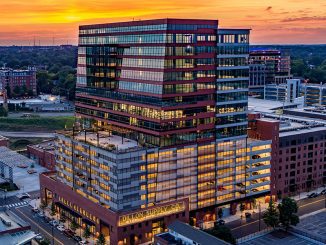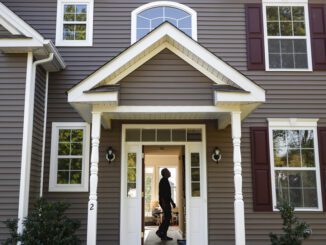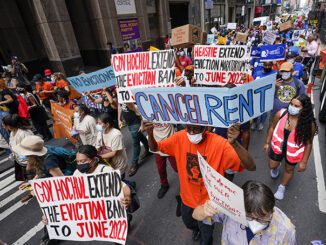We are in a housing crisis. Freddie Mac estimates that the United States needs nearly 4 million new housing units to keep up. But there’s an even larger problem rapidly becoming apparent.
The rental market – traditionally seen as a haven for Americans who can’t afford to buy into an expensive housing market – is becoming prohibitively expensive and more difficult to access for the people who need it most.
That’s the conclusion of a new study by the website Real Estate Witch, which analyzed publicly available data from the U.S. Department of Housing and Urban Development, the Federal Reserve, and the U.S. Census Bureau.
The study found that from 1985 to 2020, rents grew by 149%, while income grew by only 35% – meaning rents increased four times faster than income. As a result, 58% of today’s renters live paycheck-to-paycheck, illustrating just how precarious the basics of day-to-day life have become for many Americans.
The Pandemic Drove Up Home Values – And, Eventually, Rents
The pandemic hugely impacted the world economy, disrupting the stock market and leading to financial struggles for millions of Americans. It also affected home values and rents, but those impacts unfolded in different ways.
The market came to a virtual standstill in the early days of the pandemic, but home values skyrocketed shortly thereafter, rising a whopping 17% just in 2021. Rents fell steeply, declining by as much as 20% in some markets, before experiencing an under-the-radar rebound, eventually doubling the 2% pre-pandemic growth rate. In 2021, they increased by 3.8% and continued that trend in 2022, growing by 3.7% so far this year.
Since 2020, rent prices have shot up by 8%, a rate that tops any other two-year period at the beginning of a decade. From 1990 to 1992, rents increased by 7.4%. From 2000 to 2002, they increased by 5.7%; from 2010 to 2012, they declined by 1.3%.
As rising home values priced many prospective home buyers out of the market, more of them became renters. This led to a 5.6% vacancy rate in 2021, the lowest recorded vacancy rate since 1984. The result is that renters are being squeezed from both sides – by rising rents and a reduced supply of units.
But this isn’t an isolated pandemic-era problem; a deeper analysis suggests these trends started decades ago.
Rents Have Dramatically Outpaced Inflation in the 21st Century
Inflation’s been making headlines after spiking to 7.5% in 2021. But it’s been stealthily eroding the purchasing power of American renters for the past several decades.
Since 2000, the median rent price has exceeded the inflation rate by a whopping 29%, meaning that American renters have been forced to spend an increasing portion of their incomes on housing costs. Over that period, rents rose 90%, while inflation rose by only 70%.
The study suggests there are several reasons that rents have exceeded inflation. One is a more competitive housing market in general. Home prices have risen 156% since 2000, increasing a rate more than double that of inflation, which has pushed more would-be homebuyers into the rental market.
The second reason is that rental units have been underbuilt for years. In simple economic terms, there aren’t enough rental units to meet demand. Construction of new apartments hit a five-year low in 2020, as that industry was plagued by delays related to the labor market and sharply increasing building supplies costs.
But other studies date the housing shortage much farther back, tracing it to the Great Recession. After new construction cratered following the 2008 financial crash, it never fully recovered, meaning that the U.S. has been building fewer units than it needs for well over a decade . That shortage has led to an extra-competitive market for the units that filter into the housing supply.
Another big factor in the recent spikes is the rent freezes and eviction moratoriums that many cities and states put into place during the pandemic. After those restrictions were phased out, many landlords made up for lost time with double increases.
In addition, as remote work becomes ubiquitous across many sectors, many high earners are moving out of expensive urban areas and into lower-priced markets where their purchasing power has quickly driven up local rents and home values.
Finally, one of the biggest factors in rental affordability is one of the simplest – but important enough that it bears repeating. From 1985 to 2020, the median rent rose by 149%. Over that same period, median income grew only 35%. Rents are a lot higher while people are only making a little more money.
A Devastating Domino Effect for Millennials
Just like the pandemic had a radically different impact on rents and home prices, the inflation of rents has disparate economic impacts on younger generations.
The rent-to-income ratio is a handy snapshot of rental affordability since it shows what percentage of income the average renter can expect to spend on rent. The average rent-to-income ratio has nearly doubled since 1985, from 9% to just under 17% in 2020.
That means that in 1985 when the average baby boomer was 30, they only spent 9% of their income on rent. Today, a millennial of roughly the same age spends nearly twice as much of their income on rent.
It gets worse. Millennials have far more student debt than other generations, with the average person born in the 1990s carrying around $30,000 of debt. It also doesn’t help that young college graduates dramatically overestimate their starting salaries out of college, leading them to underestimate the financial struggles they’ll soon be facing.
Zoom out, and it’s clear how this puts millennials in a tough situation. After decades of tepid wage growth, they’re allocating a larger share of their income to rent than previous generations, while also being burdened with higher debt levels. That makes it harder to save money towards a down payment, even as skyrocketing home values and interest rates cause the amount of that down payment to balloon.
Millennials are now the largest single cohort of home buyers, so the larger housing market could soon feel the effects of their situation.
Where Have Rents Increased The Most?
The Real Estate Witch study also analyzed which markets saw the highest rent increases since 2000. Their findings are a thought-provoking look at how rent inflation has been distributed among diverse markets.
The ten markets that saw the highest rent increases between 2000 and 2022 are unpredictable, with high-priced markets like New York City, Los Angeles, Seattle, and Boston experiencing dramatic increases between 154% and 167%. At the same time, rents rose as much or more in smaller markets known for their affordability: cities like St. Louis, Buffalo, San Antonio, and Birmingham saw huge increases between 151% and 204%.
The city that saw the biggest rent spike from 2000 – 2022? Nashville, Tennessee, a southern city that’s seen an astronomical 255.9% rise in rents over the past 22 years.



